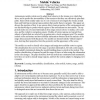Free Online Productivity Tools
i2Speak
i2Symbol
i2OCR
iTex2Img
iWeb2Print
iWeb2Shot
i2Type
iPdf2Split
iPdf2Merge
i2Bopomofo
i2Arabic
i2Style
i2Image
i2PDF
iLatex2Rtf
Sci2ools
AROBOTS
2008
2008
Learning traversability models for autonomous mobile vehicles
Autonomous mobile robots need to adapt their behavior to the terrain over which they drive, and to predict the traversability of the terrain so that they can effectively plan their paths. Such robots usually make use of a set of sensors to investigate the terrain around them and build up an internal representation that enable them to navigate. This paper addresses the question of how to use sensor data to learn properties of the environment and use this knowledge to predict which regions of the environment are traversable. The approach makes use of sensed information from range sensors (stereo or ladar), color cameras, and the vehicle's navigation sensors. Models of terrain regions are learned from subsets of pixels that are selected by projection into a local occupancy grid. The models include color and texture and traversability information obtained from an analysis of the range data associated with the pixels. The models are learned entirely without supervision, deriving their...
| Added | 08 Dec 2010 |
| Updated | 08 Dec 2010 |
| Type | Journal |
| Year | 2008 |
| Where | AROBOTS |
| Authors | Michael Shneier, Tommy Chang, Tsai Hong, William P. Shackleford, Roger Bostelman, James S. Albus |
Comments (0)

